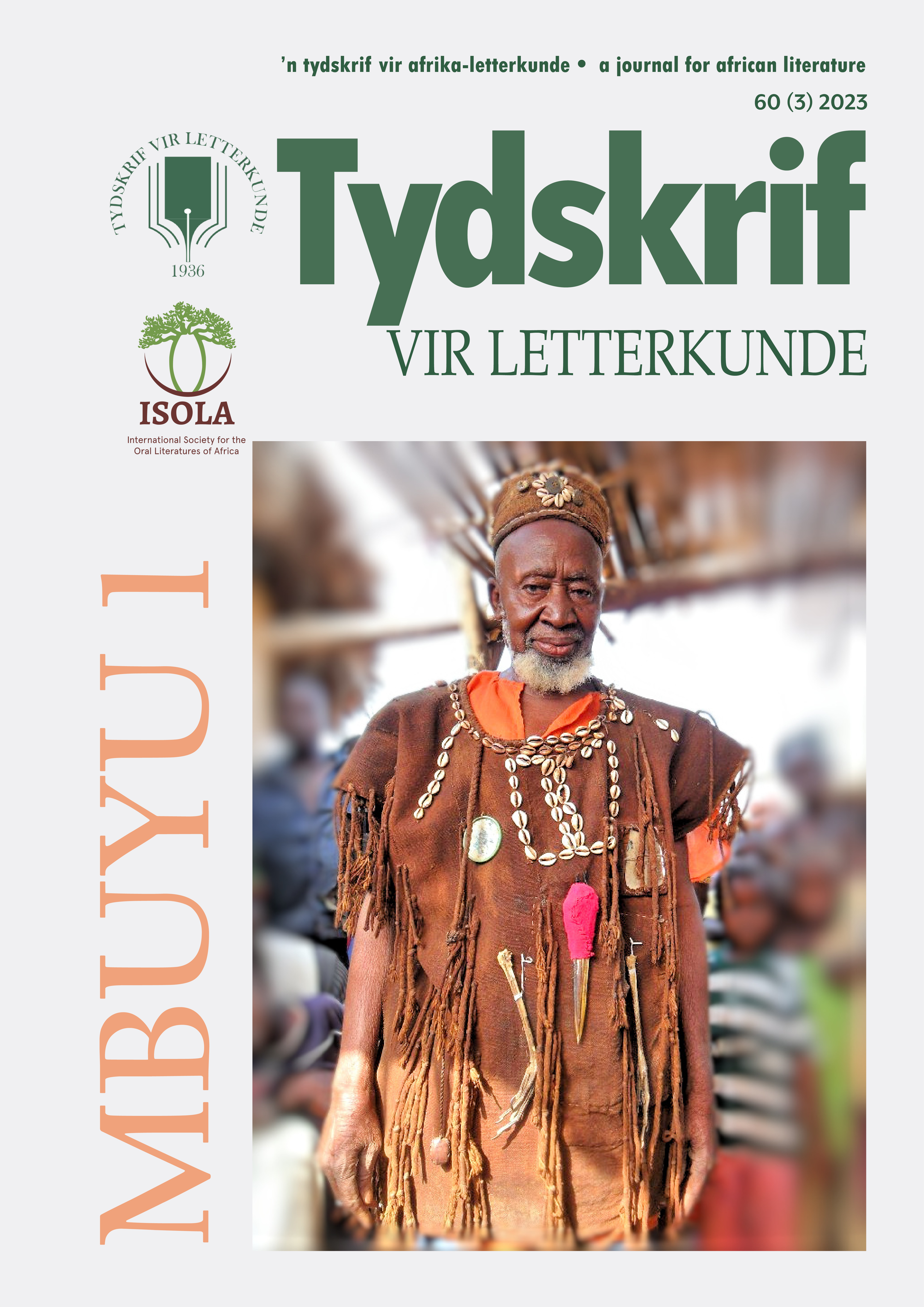Masking death: Covid-19 inspired humour in the everyday orality of a Luo community in Kenya
DOI:
https://doi.org/10.17159/tl.v60i3.14691Keywords:
Covid-19, orality, humour, maskAbstract
Death, especially death which comes through disease, is often a hard subject that the human mind wishes to bury deep in the unconscious. The lack of ease with impending death eventually finds expression in everyday discourse. In this paper I look at performance of Covid-19 discourse through humour in a short episode of everyday orality of a Luo community in Uyoma, Siaya, in Kenya. The performance of the everyday language is textualized to display the aesthetics of contextual language through coinage, jokes, and puns, which manifest as humorous responses to an otherwise dire situation. From the feminising of the disease as Acory Nyar China, literally translated as “the petite Cory from China”, to the symbolic naming of aspects of the Covid-19 protocols and verbal jokes about the same, there is an inherent, deliberate attempt to literally laugh in the face of death. The identified aspects of language are treated as metaphorical masks, even as the mask as an object also becomes a metaphor. I employ discourse analysis, which treats language as living social phenomena capable of change, growth, expansion, and adaptation for contextual spatial and temporal expressions.
Downloads
References
Amuka, Peter Sumba Okayo. “The Place of Deconstruction in the Speech of Africa: The Role of Pakruok and Ngero in Telling Culture in Dholuo.” African Philosophy as Cultural Inquiry, edited by Ivan Karp & D. A. Masolo. Indiana U P, 2000, pp. 90–103.
De Certeau, Michel. The Practice of Everyday Life, translated by Steven Rendall. U of California P, 1984.
Fairclough, Norman. Language and Power. 2nd ed. Pearson, 2001
Fairclough, Norman & Ruth Wodak. “Critical Discourse Analysis.” Discourse Studies: A Multidisciplinary Introduction, edited by Teun A. van Dijk. Vol. 2. Sage, 1997, pp. 258–84.
Freud, Sigmund. Jokes and Their Relation to the Unconscious. Read, 2014. DOI: https://doi.org/10.4324/9781315830759
Furniss, Graham. Orality: The Power of the Spoken Word. Palgrave MacMillan, 2004. DOI: https://doi.org/10.1057/9780230510111
Goffman, Erving. The Presentation of Self in Everyday Life. U of Edinburgh Social Sciences Research Centre, 1959.
Klimczuk, Andrzej & Artur Fabiś. “Theories of Death and Dying.” The Wiley-Blackwell Encyclopaedia of Social Theory, edited by Bryan S. Turner. Wiley-Blackwell, 2017, pp. 1–7. DOI: https://doi.org/10.1002/9781118430873.est0084. DOI: https://doi.org/10.1002/9781118430873.est0084
Masolo D. A. “Presencing the Past and Remembering the Present: Social Features of Popular Music in Kenya.” Music and the Racial Imagination, edited by Ronald M. Radano & Philip V. Bohlman. U of Chicago P. 2000, pp. 349–402.
Michieka, Martha & Leonard Muaka. “Humor in Kenyan Comedy.” Diversity in African languages, edited by Doris L. Payne, Sara Pacchiarotti & Mokaya Bosire. Language Science Press, 2021, pp. 559–76.
Morreall, John. “Humor, Philosophy and Education.” Educational Philosophy and Theory vol. 46, no. 2, 2014, pp. 1–12. DOI: https://doi.org/10.1080/00131857.2012.721735. DOI: https://doi.org/10.1080/00131857.2012.721735
Ogot, Bethwell A. A History of the Luo-Speaking Peoples of Eastern Africa. Anyange, 2009.
Owiti, Beatrice. “Humour in Pakruok Among the Luo of Kenya: Do Current Theories of Humour Effectively Explain Pakruok?” International Journal of Linguistics vol. 5, no. 3, 2013, pp. 28–42. DOI: https://doi.org/10.5296/ijl.v5i3.3369. DOI: https://doi.org/10.5296/ijl.v5i3.3369
Perrotta, Giulio. “Human Mechanisms of Psychological Defense: Definitions, Historical and Psychodynamic Contexts, Classifications and Clinical Profiles”. International Journal of Neurorehabilitation vol. 7, no. 1, 2020, pp. 1–7.
Rizutto, Ana-Maria. Freud and the Spoken Word: Speech as a Key to the Unconscious. Routledge, 2015. DOI: https://doi.org/10.4324/9781315718200
Wingert, Paul, S. “Mask.”. Encyclopedia Britannica. 10 Feb. 2020. https://www.britannica.com/art/mask-face-covering.
Wodak, Ruth & Michael Meyer. “Critical Discourse Analysis: History, Agenda, Theory, and Methodology 1.” Methods of Critical Discourse Analysis, edited by Ruth Wodak & Michael Meyer. Sage. 2009, pp. 1–33.
Downloads
Published
Issue
Section
License
Copyright (c) 2023 Tydskrif vir Letterkunde

This work is licensed under a Creative Commons Attribution-ShareAlike 4.0 International License.


 https://orcid.org/0000-0001-6465-6584
https://orcid.org/0000-0001-6465-6584


.png)